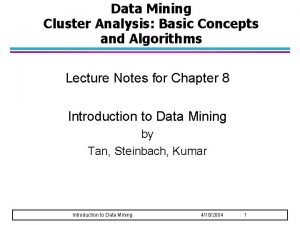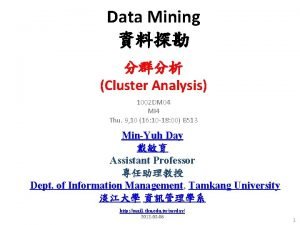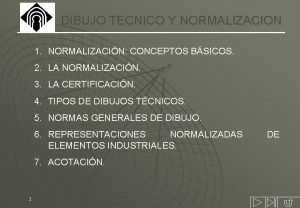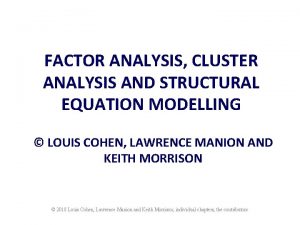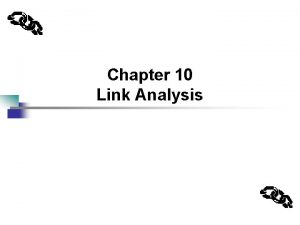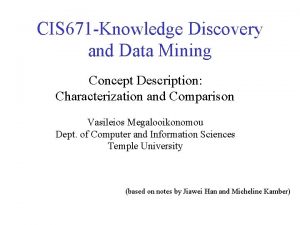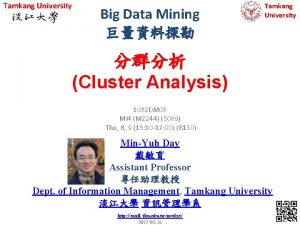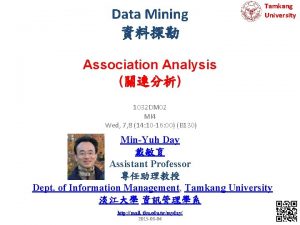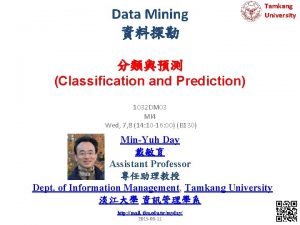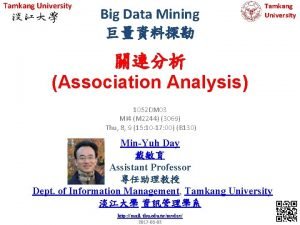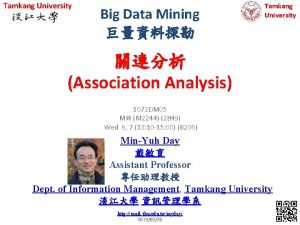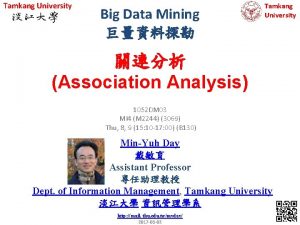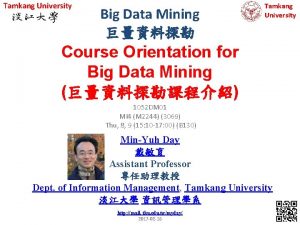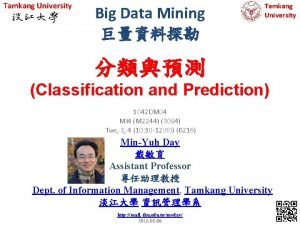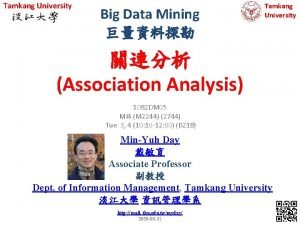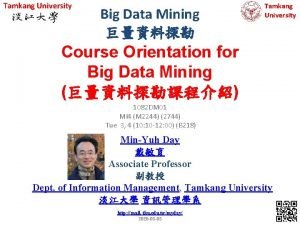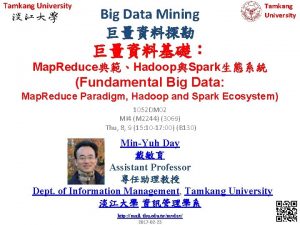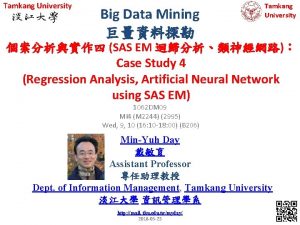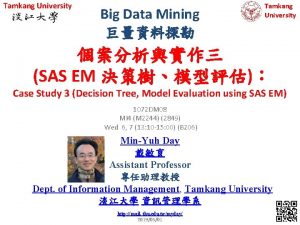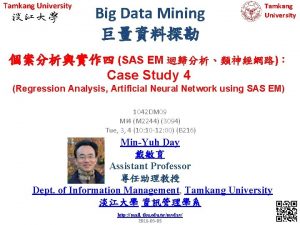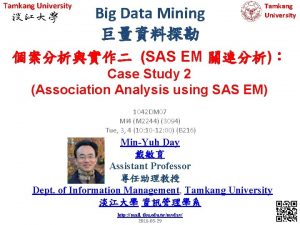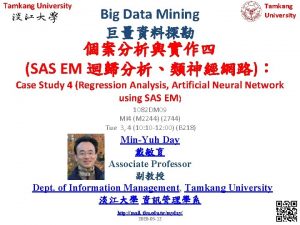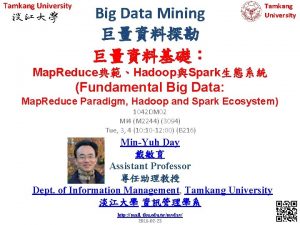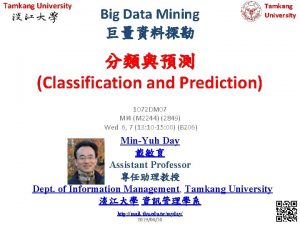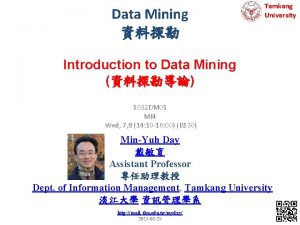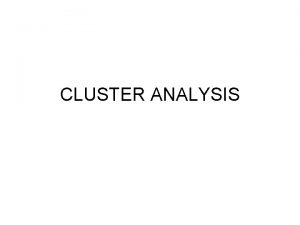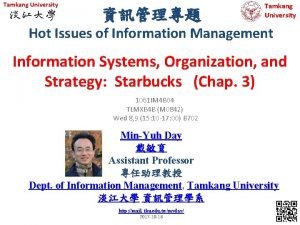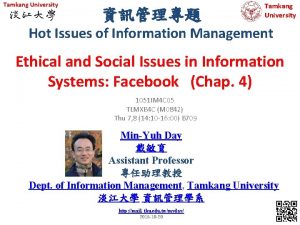Data Mining Tamkang University Cluster Analysis 1032 DM



























- Slides: 27

Data Mining 資料探勘 Tamkang University 分群分析 (Cluster Analysis) 1032 DM 04 MI 4 Wed, 7, 8 (14: 10 -16: 00) (B 130) Min-Yuh Day 戴敏育 Assistant Professor 專任助理教授 Dept. of Information Management, Tamkang University 淡江大學 資訊管理學系 http: //mail. tku. edu. tw/myday/ 2015 -03 -18 1

課程大綱 (Syllabus) 週次 (Week) 日期 (Date) 內容 (Subject/Topics) 1 2015/02/25 資料探勘導論 (Introduction to Data Mining) 2 2015/03/04 關連分析 (Association Analysis) 3 2015/03/11 分類與預測 (Classification and Prediction) 4 2015/03/18 分群分析 (Cluster Analysis) 5 2015/03/25 個案分析與實作一 (SAS EM 分群分析): EM) Case Study 1 (Cluster Analysis – K-Means using SAS 6 2015/04/01 教學行政觀摩日 (Off-campus study) 7 2015/04/08 個案分析與實作二 (SAS EM 關連分析): Case Study 2 (Association Analysis using SAS EM) 8 2015/04/15 個案分析與實作三 (SAS EM 決策樹、模型評估): Case Study 3 (Decision Tree, Model Evaluation using SAS EM) 2

課程大綱 (Syllabus) 週次 (Week) 日期 (Date) 內容 (Subject/Topics) 9 2015/04/22 期中報告 (Midterm Project Presentation) 10 2015/04/29 期中考試週 (Midterm Exam) 11 2015/05/06 個案分析與實作四 (SAS EM 迴歸分析、類神經網路): Case Study 4 (Regression Analysis, Artificial Neural Network using SAS EM) 12 2015/05/13 海量資料分析 (Big Data Analytics) 13 2015/05/20 文字探勘與網頁探勘 (Text and Web Mining) 14 2015/05/27 期末報告 (Final Project Presentation) 15 2015/06/03 畢業考試週 (Final Exam) 3

A Taxonomy for Data Mining Tasks Source: Turban et al. (2011), Decision Support and Business Intelligence Systems 4

Outline • Cluster Analysis • K-Means Clustering Source: Han & Kamber (2006) 5

Cluster Analysis • Used for automatic identification of natural groupings of things • Part of the machine-learning family • Employ unsupervised learning • Learns the clusters of things from past data, then assigns new instances • There is not an output variable • Also known as segmentation Source: Turban et al. (2011), Decision Support and Business Intelligence Systems 6

Cluster Analysis Clustering of a set of objects based on the k-means method. (The mean of each cluster is marked by a “+”. ) Source: Han & Kamber (2006) 7

Cluster Analysis • Clustering results may be used to – Identify natural groupings of customers – Identify rules for assigning new cases to classes for targeting/diagnostic purposes – Provide characterization, definition, labeling of populations – Decrease the size and complexity of problems for other data mining methods – Identify outliers in a specific domain (e. g. , rare-event detection) Source: Turban et al. (2011), Decision Support and Business Intelligence Systems 8

Example of Cluster Analysis 10 Point p 01 p 02 p 03 p 04 p 05 p 06 p 07 p 08 p 09 p 10 9 8 7 6 5 4 3 2 P a b c d e f g h i j P(x, y) (3, 4) (3, 6) (3, 8) (4, 5) (4, 7) (5, 1) (5, 5) (7, 3) (7, 5) (8, 5) 1 0 0 1 2 3 4 5 6 7 8 9 10 9

Cluster Analysis for Data Mining • Analysis methods – Statistical methods (including both hierarchical and nonhierarchical), such as k-means, k-modes, and so on – Neural networks (adaptive resonance theory [ART], self-organizing map [SOM]) – Fuzzy logic (e. g. , fuzzy c-means algorithm) – Genetic algorithms • Divisive versus Agglomerative methods Source: Turban et al. (2011), Decision Support and Business Intelligence Systems 10

Cluster Analysis for Data Mining • How many clusters? – There is not a “truly optimal” way to calculate it – Heuristics are often used 1. 2. 3. 4. Look at the sparseness of clusters Number of clusters = (n/2)1/2 (n: no of data points) Use Akaike information criterion (AIC) Use Bayesian information criterion (BIC) • Most cluster analysis methods involve the use of a distance measure to calculate the closeness between pairs of items – Euclidian versus Manhattan (rectilinear) distance Source: Turban et al. (2011), Decision Support and Business Intelligence Systems 11

k-Means Clustering Algorithm • k : pre-determined number of clusters • Algorithm (Step 0: determine value of k) Step 1: Randomly generate k random points as initial cluster centers Step 2: Assign each point to the nearest cluster center Step 3: Re-compute the new cluster centers Repetition step: Repeat steps 2 and 3 until some convergence criterion is met (usually that the assignment of points to clusters becomes stable) Source: Turban et al. (2011), Decision Support and Business Intelligence Systems 12

Cluster Analysis for Data Mining k-Means Clustering Algorithm Source: Turban et al. (2011), Decision Support and Business Intelligence Systems 13

Similarity and Dissimilarity Between Objects • Distances are normally used to measure the similarity or dissimilarity between two data objects • Some popular ones include: Minkowski distance: where i = (xi 1, xi 2, …, xip) and j = (xj 1, xj 2, …, xjp) are two pdimensional data objects, and q is a positive integer • If q = 1, d is Manhattan distance Source: Han & Kamber (2006) 14

Similarity and Dissimilarity Between Objects (Cont. ) • If q = 2, d is Euclidean distance: – Properties • d(i, j) 0 • d(i, i) = 0 • d(i, j) = d(j, i) • d(i, j) d(i, k) + d(k, j) • Also, one can use weighted distance, parametric Pearson product moment correlation, or other disimilarity measures Source: Han & Kamber (2006) 15

Euclidean distance vs Manhattan distance • Distance of two point x 1 = (1, 2) and x 2 (3, 5) 5 4 3. 61 3 2 x 1 = (1, 2) 1 2 3 Euclidean distance: = ((3 -1)2 + (5 -2)2 )1/2 = (22 + 32)1/2 = (4 + 9)1/2 = (13)1/2 = 3. 61 Manhattan distance: = (3 -1) + (5 -2) =2+3 =5 16

The K-Means Clustering Method • Example 10 10 9 9 8 8 7 7 6 6 5 5 4 3 2 1 0 0 1 2 3 4 5 6 7 8 9 10 Assign each objects to most similar center Update the cluster means reassign 4 3 2 1 0 0 1 2 3 4 5 6 7 8 9 10 reassign K=2 Arbitrarily choose K object as initial cluster center Update the cluster means Source: Han & Kamber (2006) 17

K-Means Clustering Step by Step 10 Point p 01 p 02 p 03 p 04 p 05 p 06 p 07 p 08 p 09 p 10 9 8 7 6 5 4 3 2 P a b c d e f g h i j P(x, y) (3, 4) (3, 6) (3, 8) (4, 5) (4, 7) (5, 1) (5, 5) (7, 3) (7, 5) (8, 5) 1 0 0 1 2 3 4 5 6 7 8 9 10 18

K-Means Clustering Step 1: K=2, Arbitrarily choose K object as initial cluster center 10 9 8 7 6 M 2 = (8, 5) 5 4 m 1 = (3, 4) 3 2 P a b c d e f g h i j Initial m 1 Initial m 2 1 0 Point p 01 p 02 p 03 p 04 p 05 p 06 p 07 p 08 p 09 p 10 0 1 2 3 4 5 6 7 8 9 P(x, y) (3, 4) (3, 6) (3, 8) (4, 5) (4, 7) (5, 1) (5, 5) (7, 3) (7, 5) (8, 5) (3, 4) (8, 5) 10 19

Step 2: Compute seed points as the centroids of the clusters of the current partition Step 3: Assign each objects to most similar center m 1 m 2 distance Point P P(x, y) p 01 a (3, 4) 0. 00 5. 10 Cluster 1 p 02 b (3, 6) 2. 00 5. 10 Cluster 1 p 03 c (3, 8) 4. 00 5. 83 Cluster 1 p 04 d (4, 5) 1. 41 4. 00 Cluster 1 p 05 e (4, 7) 3. 16 4. 47 Cluster 1 p 06 f (5, 1) 3. 61 5. 00 Cluster 1 p 07 g (5, 5) 2. 24 3. 00 Cluster 1 2 p 08 h (7, 3) 4. 12 2. 24 Cluster 2 1 p 09 i (7, 5) 4. 12 1. 00 Cluster 2 0 p 10 j (8, 5) 5. 10 0. 00 Cluster 2 10 9 8 7 6 M 2 = (8, 5) 5 4 m 1 = (3, 4) 3 0 1 2 3 4 5 6 7 8 9 10 K-Means Clustering Cluster Initial m 1 (3, 4) Initial m 2 (8, 5) 20

Step 2: Compute seed points as the centroids of the clusters of the current partition Step 3: Assign each objects to most similar center 10 9 8 7 6 M 2 = (8, 5) 5 4 3 2 1 0 P P(x, y) p 01 a (3, 4) 0. 00 5. 10 Cluster 1 p 02 b (3, 6) 2. 00 5. 10 Cluster 1 p 03 c (3, 8) 4. 00 5. 83 Cluster 1 p 04 d (4, 5) 1. 41 4. 00 Cluster 1 e (4, 7) 3. 16 4. 47 Euclidean distance b(3, 6) m 2(8, 5) f (5, 1) 3. 61 5. 00 2 =g((8 -3) (5 -6)23. 00 )1/2 (5, 5) +2. 24 2)1/2 =h(52(7, +3)(-1)4. 12 2. 24 1/2 = i(25 + 1) (7, 5) 4. 12 1. 00 1/2 = j(26) (8, 5) 5. 10 0. 00 = 5. 10 Cluster 1 p 05 p 06 m 1 = (3, 4) Euclidean distance b(3, 6) m 1(3, 4) = ((3 -3)2 + (4 -6)2 )1/2 0 1 =2(032 +4(-2) 5 2)61/27 8 9 = (0 + 4)1/2 K-Means = (4)1/2 Clustering = 2. 00 p 07 p 08 p 09 10 m 1 m 2 distance Point p 10 Cluster 1 Cluster 2 Initial m 1 (3, 4) Initial m 2 (8, 5) 21

Step 4: Update the cluster means, Repeat Step 2, 3, Point stop when no more new assignment 10 p 01 9 p 02 8 p 03 7 p 04 6 m 1 = (3. 86, 5. 14) p 05 5 p 06 4 M = (7. 33, 4. 33) P P(x, y) m 1 m 2 distance Cluster a (3, 4) 1. 43 4. 34 Cluster 1 b (3, 6) 1. 22 4. 64 Cluster 1 c (3, 8) 2. 99 5. 68 Cluster 1 d (4, 5) 0. 20 3. 40 Cluster 1 e (4, 7) 1. 87 4. 27 Cluster 1 f (5, 1) 4. 29 4. 06 Cluster 2 3 p 07 g (5, 5) 1. 15 2. 42 Cluster 1 2 p 08 h (7, 3) 3. 80 1. 37 Cluster 2 1 p 09 i (7, 5) 3. 14 0. 75 Cluster 2 p 10 j (8, 5) 4. 14 0. 95 Cluster 2 2 0 0 1 2 3 4 5 6 7 8 9 10 K-Means Clustering m 1 (3. 86, 5. 14) m 2 (7. 33, 4. 33) 22

Step 4: Update the cluster means, Repeat Step 2, 3, Point stop when no more new assignment 10 p 01 9 p 02 8 p 03 7 p 04 m 1 = (3. 67, 5. 83) 6 p 05 5 M 2 = (6. 75. , 3. 50) p 06 4 P P(x, y) m 1 m 2 distance Cluster a (3, 4) 1. 95 3. 78 Cluster 1 b (3, 6) 0. 69 4. 51 Cluster 1 c (3, 8) 2. 27 5. 86 Cluster 1 d (4, 5) 0. 89 3. 13 Cluster 1 e (4, 7) 1. 22 4. 45 Cluster 1 f (5, 1) 5. 01 3. 05 Cluster 2 3 p 07 g (5, 5) 1. 57 2. 30 Cluster 1 2 p 08 h (7, 3) 4. 37 0. 56 Cluster 2 1 p 09 i (7, 5) 3. 43 1. 52 Cluster 2 p 10 j (8, 5) 4. 41 1. 95 Cluster 2 0 0 1 2 3 4 5 6 7 8 9 10 K-Means Clustering m 1 (3. 67, 5. 83) m 2 (6. 75, 3. 50) 23

stop when no more new assignment Point 10 p 01 P P(x, y) m 1 m 2 distance Cluster a (3, 4) 1. 95 3. 78 Cluster 1 p 02 b (3, 6) 0. 69 4. 51 Cluster 1 p 03 c (3, 8) 2. 27 5. 86 Cluster 1 p 04 d (4, 5) 0. 89 3. 13 Cluster 1 5 p 05 e (4, 7) 1. 22 4. 45 Cluster 1 4 p 06 f (5, 1) 5. 01 3. 05 Cluster 2 3 p 07 g (5, 5) 1. 57 2. 30 Cluster 1 2 p 08 h (7, 3) 4. 37 0. 56 Cluster 2 1 p 09 i (7, 5) 3. 43 1. 52 Cluster 2 p 10 j (8, 5) 4. 41 1. 95 Cluster 2 9 8 7 6 0 0 1 2 3 4 5 6 7 8 9 10 K-Means Clustering m 1 (3. 67, 5. 83) m 2 (6. 75, 3. 50) 24

K-Means Clustering (K=2, two clusters) stop when no more new assignment Point 10 p 01 P P(x, y) m 1 m 2 distance Cluster a (3, 4) 1. 95 3. 78 Cluster 1 p 02 b (3, 6) 0. 69 4. 51 Cluster 1 p 03 c (3, 8) 2. 27 5. 86 Cluster 1 p 04 d (4, 5) 0. 89 3. 13 Cluster 1 5 p 05 e (4, 7) 1. 22 4. 45 Cluster 1 4 p 06 f (5, 1) 5. 01 3. 05 Cluster 2 3 p 07 g (5, 5) 1. 57 2. 30 Cluster 1 2 p 08 h (7, 3) 4. 37 0. 56 Cluster 2 1 p 09 i (7, 5) 3. 43 1. 52 Cluster 2 p 10 j (8, 5) 4. 41 1. 95 Cluster 2 9 8 7 6 0 0 1 2 3 4 5 6 7 8 9 10 K-Means Clustering m 1 (3. 67, 5. 83) m 2 (6. 75, 3. 50) 25

Summary • Cluster Analysis • K-Means Clustering Source: Han & Kamber (2006) 26

References • Jiawei Han and Micheline Kamber, Data Mining: Concepts and Techniques, Second Edition, 2006, Elsevier • Efraim Turban, Ramesh Sharda, Dursun Delen, Decision Support and Business Intelligence Systems, Ninth Edition, 2011, Pearson. 27
 Cluster analysis data mining
Cluster analysis data mining Mining complex types of data in data mining
Mining complex types of data in data mining What is a cluster in data mining
What is a cluster in data mining Mining multimedia databases in data mining
Mining multimedia databases in data mining Ventajas de la normalizacion en dibujo tecnico
Ventajas de la normalizacion en dibujo tecnico Strip mining vs open pit mining
Strip mining vs open pit mining Mineral resources and mining chapter 13
Mineral resources and mining chapter 13 Difference between strip mining and open pit mining
Difference between strip mining and open pit mining Difference between text mining and web mining
Difference between text mining and web mining Kmo test
Kmo test Link analysis in data mining
Link analysis in data mining What is concept description in data mining
What is concept description in data mining Data reduction in data mining
Data reduction in data mining What is kdd process in data mining
What is kdd process in data mining What is missing data in data mining
What is missing data in data mining Concept hierarchy generation for nominal data
Concept hierarchy generation for nominal data Data reduction in data mining
Data reduction in data mining Data reduction in data mining
Data reduction in data mining Data cube technology in data mining
Data cube technology in data mining Data reduction in data mining
Data reduction in data mining Perbedaan data warehouse dan data mining
Perbedaan data warehouse dan data mining Perbedaan data warehouse dan data mining
Perbedaan data warehouse dan data mining Analitical cubism
Analitical cubism Complex data types in data mining
Complex data types in data mining Data warehousing olap and data mining
Data warehousing olap and data mining Noisy data in data mining
Noisy data in data mining 3 tier architecture of data warehouse
3 tier architecture of data warehouse Data preparation for data mining
Data preparation for data mining
